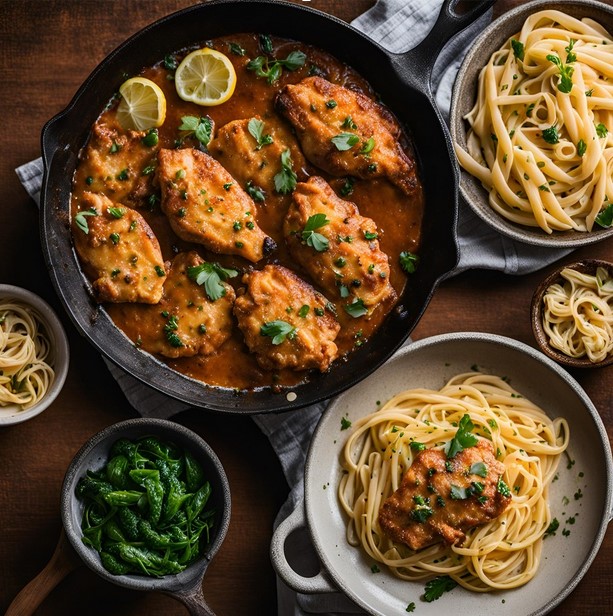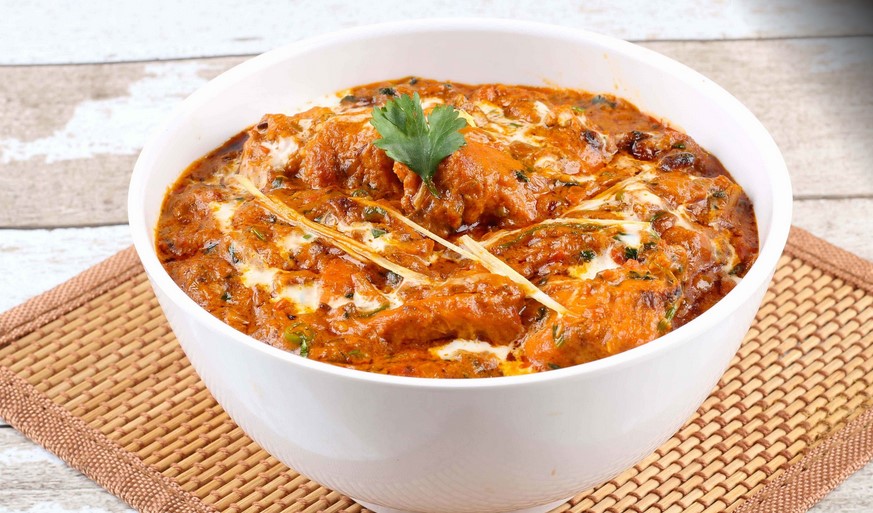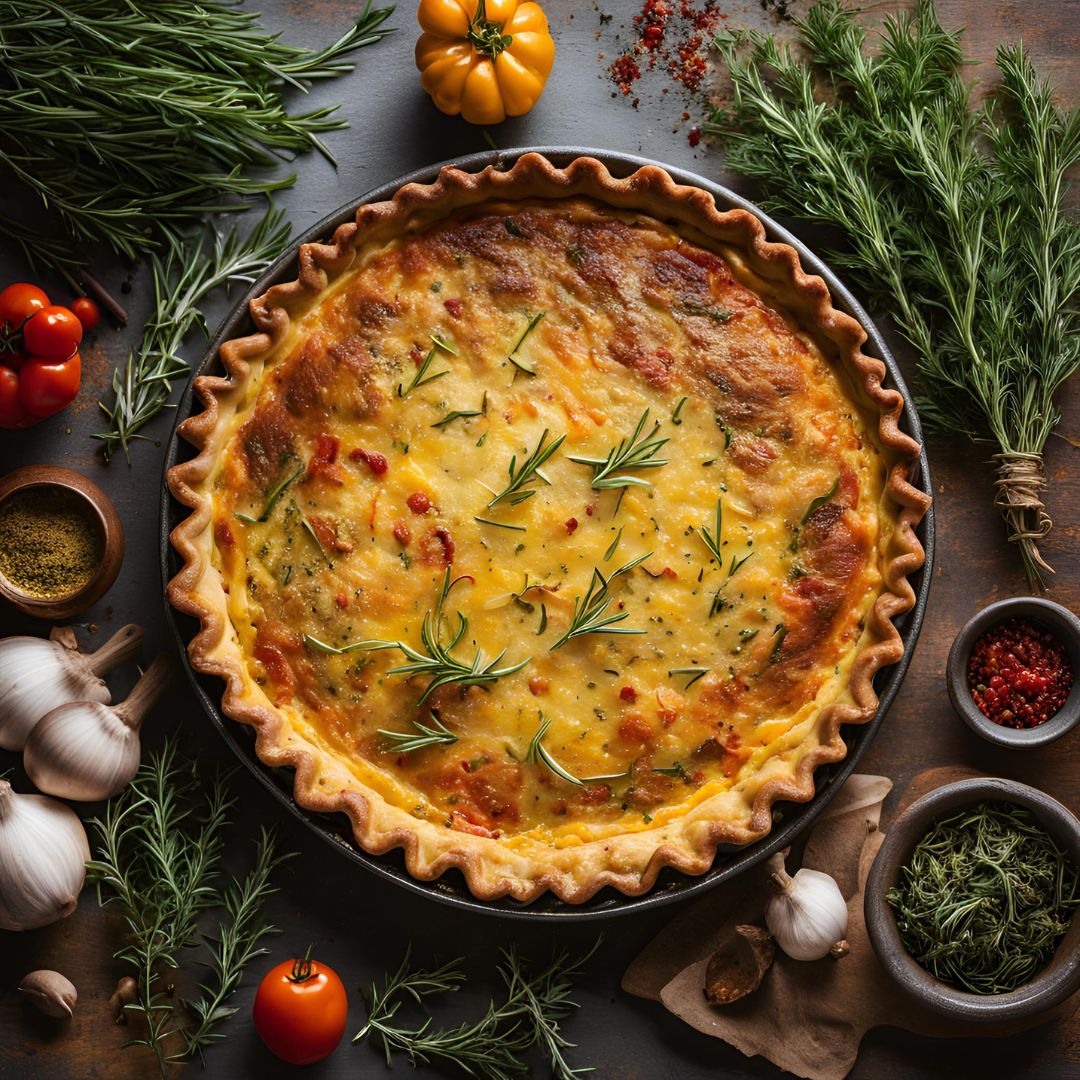Chicken Piccata Recipe – A Taste of Italy at Your Table. Italian cuisine is known for its rich flavors, fresh ingredients, and time-honored traditions. One dish that perfectly embodies these qualities is Chicken Piccata. This classic Italian recipe is a flavorful, light, and tangy dish that combines tender chicken with a zesty lemon-butter sauce, capers, and fresh herbs. Simple yet sophisticated, Chicken Piccata is a delightful way to bring the essence of Italian cooking to your dining table.
Chicken Piccata is believed to have originated from Piccata di Vitello, or veal piccata, a dish made with thin slices of veal sautéed in a pan with a bright, lemony sauce. Over time, chicken became a popular substitute for veal due to its affordability and accessibility. As a result, Chicken Piccata is now more commonly served in homes and restaurants worldwide. It’s a dish that perfectly balances flavors, making it both comforting and gourmet, suitable for both casual weeknight dinners and elegant occasions.
In this article, we will explore the history, ingredients, preparation, and tips for perfecting this iconic dish. Whether you’re a beginner or an experienced cook, mastering Chicken Piccata will elevate your culinary skills and add a versatile and impressive recipe to your repertoire.
The Origins and History of Chicken Piccata
Chicken Piccata, like many Italian dishes, has its roots in the rich culinary traditions of Italy. The word “piccata” comes from the Italian verb “piccare,” which means “to prick” or “to pounce,” referencing the sharp and tangy flavors that characterize the sauce. While the exact origins of Chicken Piccata are unclear, its ancestor, veal piccata, dates back to the early 20th century in Northern Italy, a region known for its use of butter, lemons, and fresh herbs in cooking.
Historically, veal was a prized meat in Italy, and the classic preparation of veal piccata involved thinly sliced veal that was lightly dredged in flour, sautéed, and then finished in a tangy lemon-caper sauce. Over time, as chicken became more widely available and affordable, cooks adapted the recipe to suit their needs, resulting in the Chicken Piccata we know and love today.
In the mid-20th century, Italian immigrants brought their beloved recipes to the United States, where Chicken Piccata became a popular dish in Italian-American restaurants. Its bright, citrusy sauce appealed to American palates, and it soon became a staple on menus across the country. Today, Chicken Piccata is enjoyed around the world for its ease of preparation and its ability to transform simple ingredients into a flavorful and elegant meal.
The Essential Ingredients of Chicken Piccata
The beauty of Chicken Piccata lies in its simplicity. With just a handful of ingredients, this dish delivers a burst of flavor that is both vibrant and comforting. Let’s take a closer look at the key components of Chicken Piccata:
Chicken Breasts:
The star of the dish, chicken breasts are used for their tender, lean meat. Pounding the chicken breasts to an even thickness ensures quick and even cooking, while also allowing the chicken to absorb the flavors of the sauce. Some variations of the dish may use chicken thighs for a slightly richer flavor.
Flour:
A light coating of all-purpose flour helps create a golden, crispy crust on the chicken when it’s sautéed. The flour also helps thicken the sauce slightly as it cooks, giving it a velvety texture.
Lemon Juice:
Fresh lemon juice is the defining flavor in Chicken Piccata, providing a bright, tangy contrast to the richness of the butter and the mildness of the chicken. The acidity of the lemon cuts through the fat, balancing the dish perfectly.
Capers:
These small, briny buds add a burst of salty, tangy flavor to the dish. Capers are a staple in Mediterranean cuisine and lend a unique, zesty note to the sauce, complementing the lemon juice beautifully.
Butter:
Butter is used both for sautéing the chicken and for finishing the sauce, giving it a rich, silky texture. In traditional Italian cooking, butter is often paired with olive oil to achieve a balanced flavor and to prevent the butter from burning.
White Wine (optional):
Some recipes include a splash of white wine, which adds depth and complexity to the sauce. The wine is usually reduced in the pan after sautéing the chicken, allowing its flavors to concentrate and mingle with the other ingredients.
Chicken Broth:
Chicken broth serves as the base for the sauce, adding moisture and a subtle savory flavor. Low-sodium broth is often recommended to avoid overpowering the delicate flavors of the lemon and capers.
Fresh Parsley:
Chopped fresh parsley is typically used as a garnish, adding a pop of color and a hint of freshness to the final dish. It helps balance the richness of the sauce and enhances the overall presentation.
A Dish for All Occasions
Chicken Piccata is a dish that offers a harmonious blend of flavors and textures—tender chicken, a bright and tangy lemon sauce, and the subtle saltiness of capers. Whether you’re preparing it for a quick weeknight meal or for a special dinner party, Chicken Piccata is a crowd-pleaser that is sure to impress. Its simplicity, versatility, and elegance make it a timeless classic in the world of Italian cuisine.
Chicken Piccata Recipe for 4 Persons
Total Cooking Time: 30-40 minutes
Preparation Time: 10-15 minutes
Cooking Time: 20-25 minutes
Ingredients for Chicken Piccata Recipe
For the Chicken:
- 4 Chicken breasts (boneless, skinless, pounded thin)
- 1/2 cup All-purpose flour (for dredging)
- Salt and pepper (to taste)
- 3 tbsp Olive oil
- 2 tbsp Butter
For the Sauce:
- 1/2 cup Chicken broth
- 1/3 cup Lemon juice (freshly squeezed)
- 1/4 cup Capers (rinsed)
- 1/4 cup White wine (optional)
- 2 tbsp Butter
- 2 tbsp Fresh parsley (chopped, for garnish)
Cooking Instructions: Chicken Piccata Recipe
Step 1: Prepare the Chicken
Pound the Chicken: Place chicken breasts between two sheets of plastic wrap and pound them evenly until about 1/2 inch thick.
Season the Chicken: Sprinkle salt and pepper on both sides of the chicken breasts.
Dredge the Chicken: Coat the chicken breasts lightly with all-purpose flour, shaking off the excess.
Step 2: Cook the Chicken
Heat the Pan: In a large skillet, heat olive oil and 2 tbsp of butter over medium-high heat.
Cook the Chicken: Place the dredged chicken breasts in the hot skillet and cook for about 3-4 minutes on each side until golden brown. Remove the chicken from the pan and set aside.
Step 3: Prepare the Piccata Sauce
Deglaze the Pan: In the same skillet, add white wine (optional) and scrape the browned bits from the pan. Allow it to reduce by half.
Add Lemon Juice and Broth: Stir in the lemon juice, chicken broth, and capers. Bring to a simmer.
Finish the Sauce: Lower the heat and whisk in the remaining 2 tbsp of butter. Let the sauce thicken for 1-2 minutes.
Step 4: Combine Chicken and Sauce
Return Chicken to the Pan: Place the cooked chicken back into the skillet, coating each piece with the sauce. Let it simmer for 2-3 minutes so the chicken absorbs the flavors.
Garnish: Sprinkle with fresh parsley.
Some More Interesting Recipes –
- Chicken Orzo Recipe
- Chicken Provençal recipe
- Vineyard Chicken Recipe
- Chicken Marengo Recipe
- Chicken Dijon Recipe
- Rosemary Chicken Recipe
- Chicken Florentine Recipe
- Tarragon Chicken Recipe
- Chicken Fricassee Recipe
- Chicken Enchiladas Recipe
- Chicken Tikka Masala Recipe
- Butter Chicken Recipe
FAQs: Chicken Piccata Recipe
1. What is Chicken Piccata?
Chicken Piccata is a classic Italian dish made with thin, sautéed chicken breasts served in a tangy, buttery lemon and caper sauce. It’s known for its bright, fresh flavors and is often served with pasta, potatoes, or vegetables.
2. What does “piccata” mean?
“Piccata” is an Italian term referring to a preparation style where meat (usually veal or chicken) is sliced thin, dredged in flour, sautéed, and served in a lemony, butter-based sauce. The name comes from the Italian word “piccare,” meaning “to prick” or “to pounce,” referencing the dish’s bold, tangy flavors.
3. Can I use chicken thighs instead of breasts?
Yes, chicken thighs can be used for a richer flavor, though they may require a bit more cooking time. Boneless, skinless thighs work best, and you should still pound them to an even thickness for even cooking.
4. What can I serve with Chicken Piccata?
Chicken Piccata pairs well with:
Pasta (such as angel hair or spaghetti)
Mashed potatoes or roasted potatoes
Steamed vegetables (like broccoli, green beans, or asparagus)
Rice or quinoa
Crusty bread to soak up the sauce
5. Can I make this recipe of Chicken Piccata ahead of time?
Yes, you can prepare Chicken Piccata ahead of time. Cook the chicken and sauce as directed, then store them separately in the refrigerator. Reheat the sauce gently in a skillet and add the chicken to warm through before serving.
6. How do I keep the chicken tender and juicy?
To ensure the chicken stays tender:
Pound the chicken evenly: This allows the chicken to cook evenly and quickly, preventing it from drying out.
Don’t overcook: Cook the chicken until it’s just done (internal temperature of 165°F/75°C). Overcooking can result in dry, tough meat.
Let the chicken rest: After sautéing, let the chicken rest for a couple of minutes to retain its juices before serving.
7. Can I make this recipe of Chicken Piccata without capers?
Yes, if you’re not a fan of capers or don’t have them on hand, you can leave them out or substitute them with green olives for a similar briny flavor. The dish will still be delicious, though capers do add a distinct tang that complements the lemon sauce.
8. Can I substitute white wine in this recipe of Chicken Piccata?
If you prefer not to use white wine, you can simply omit it or replace it with extra chicken broth. The wine adds depth and a subtle acidity, but the dish is still flavorful without it. Another alternative is to use a splash of white wine vinegar or apple cider vinegar.
9. How do I thicken the sauce this recipe of Chicken Piccata?
The sauce naturally thickens slightly as it reduces, but if you prefer a thicker sauce:
Coat the chicken with flour before sautéing; the flour will help thicken the sauce as it simmers.
You can also whisk in a small slurry of flour or cornstarch mixed with water to the sauce, but this is rarely needed in traditional recipes.
10. Is this recipe of Chicken Piccata gluten-free?
This recipe of Chicken Piccata can easily be made gluten-free by replacing the all-purpose flour with a gluten-free flour blend or cornstarch for dredging the chicken. Ensure that the broth and other ingredients are also gluten-free.
11. How long does Chicken Piccata last in the fridge?
Chicken Piccata can be stored in an airtight container in the refrigerator for up to 3 days. When reheating, warm it gently over low heat in a skillet to maintain the tenderness of the chicken and the texture of the sauce.
12. Can I freeze Chicken Piccata?
Yes, Chicken Piccata can be frozen. Place the cooked chicken and sauce in an airtight container or freezer bag and freeze for up to 2 months. When ready to serve, thaw in the refrigerator overnight and reheat gently in a skillet. The sauce may separate slightly, but whisking in a bit of fresh butter or broth can help restore its texture.
13. Why does my sauce taste too sour?
If your sauce is too sour, it may have too much lemon juice or reduced too much while cooking. To balance the flavors:
Add more broth or water to dilute the sauce.
Whisk in extra butter, which can mellow out the acidity.
Add a pinch of sugar to balance the tartness.
14. How can I make the sauce creamier this recipe of Chicken Piccata?
For a creamier Chicken Piccata sauce in this recipe, you can:
Add a splash of heavy cream to the sauce after it has reduced.
Whisk in more butter for a richer, silkier texture.
You could also fold in a bit of crème fraîche or sour cream for an added tangy creaminess.
15. Can I make this recipe of Chicken Piccata in the oven?
While the traditional method involves stovetop sautéing, you can adapt Chicken Piccata for the oven:
Sear the chicken on the stove as usual, then transfer it to an oven-safe dish.
Pour the sauce over the chicken and bake at 350°F (175°C) for about 15-20 minutes until fully cooked. This method is useful if you’re making a larger batch or want to keep the chicken warm without overcooking it.
Chicken Piccata Recipe
Ingredients for Chicken Piccata Recipe
For the Chicken:
For the Sauce:
Cooking Instructions: Chicken Piccata Recipe
Step 1: Prepare the Chicken
- Pound the Chicken: Place chicken breasts between two sheets of plastic wrap and pound them evenly until about 1/2 inch thick.
- Season the Chicken: Sprinkle salt and pepper on both sides of the chicken breasts.
- Dredge the Chicken: Coat the chicken breasts lightly with all-purpose flour, shaking off the excess.
Step 2: Cook the Chicken
- Heat the Pan: In a large skillet, heat olive oil and 2 tbsp of butter over medium-high heat.
- Cook the Chicken: Place the dredged chicken breasts in the hot skillet and cook for about 3-4 minutes on each side until golden brown. Remove the chicken from the pan and set aside.
Step 3: Prepare the Piccata Sauce
- Deglaze the Pan: In the same skillet, add white wine (optional) and scrape the browned bits from the pan. Allow it to reduce by half.
- Add Lemon Juice and Broth: Stir in the lemon juice, chicken broth, and capers. Bring to a simmer.
- Finish the Sauce: Lower the heat and whisk in the remaining 2 tbsp of butter. Let the sauce thicken for 1-2 minutes.
Step 4: Combine Chicken and Sauce
- Return Chicken to the Pan: Place the cooked chicken back into the skillet, coating each piece with the sauce. Let it simmer for 2-3 minutes so the chicken absorbs the flavors.
- Garnish: Sprinkle with fresh parsley.






